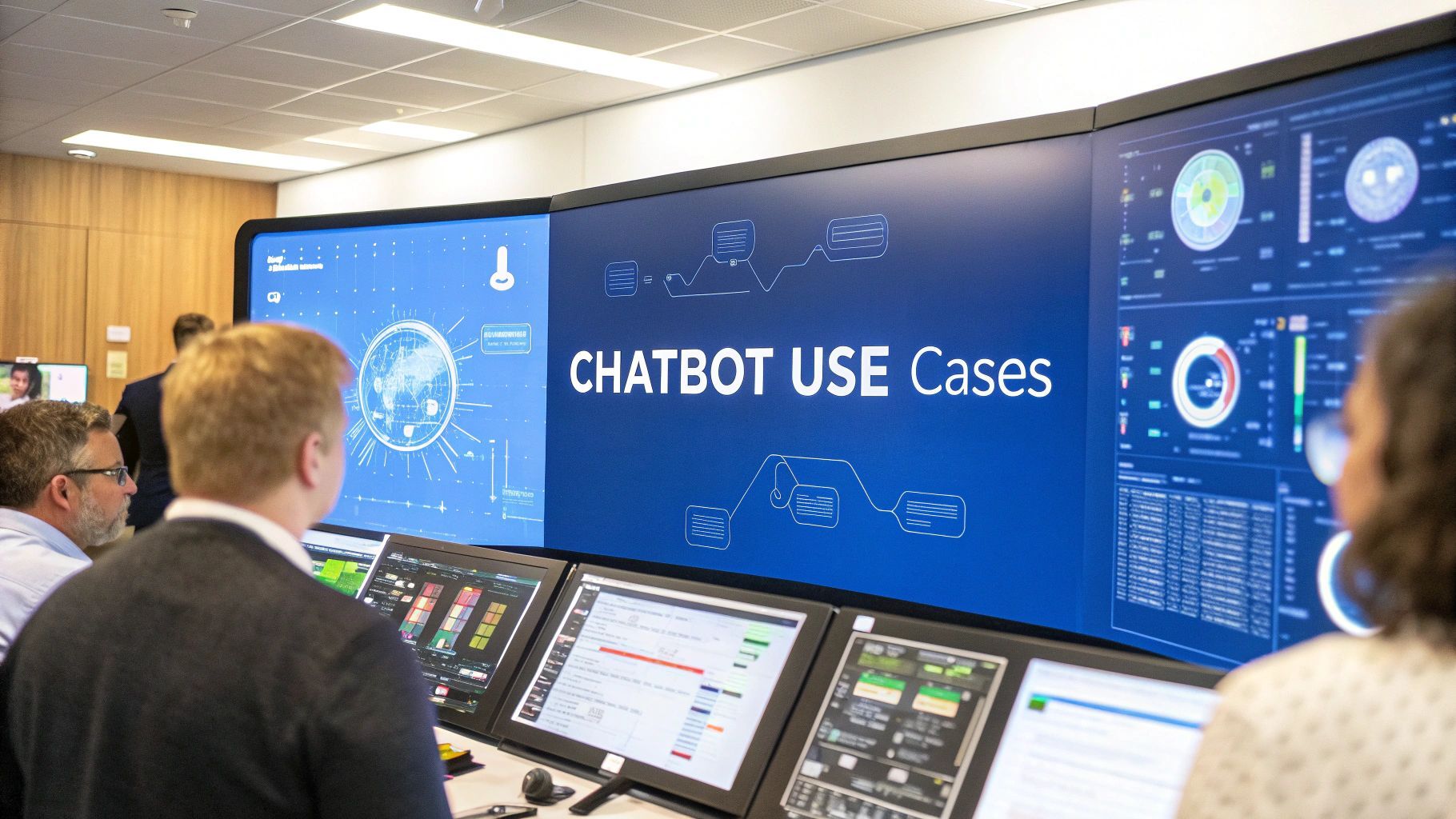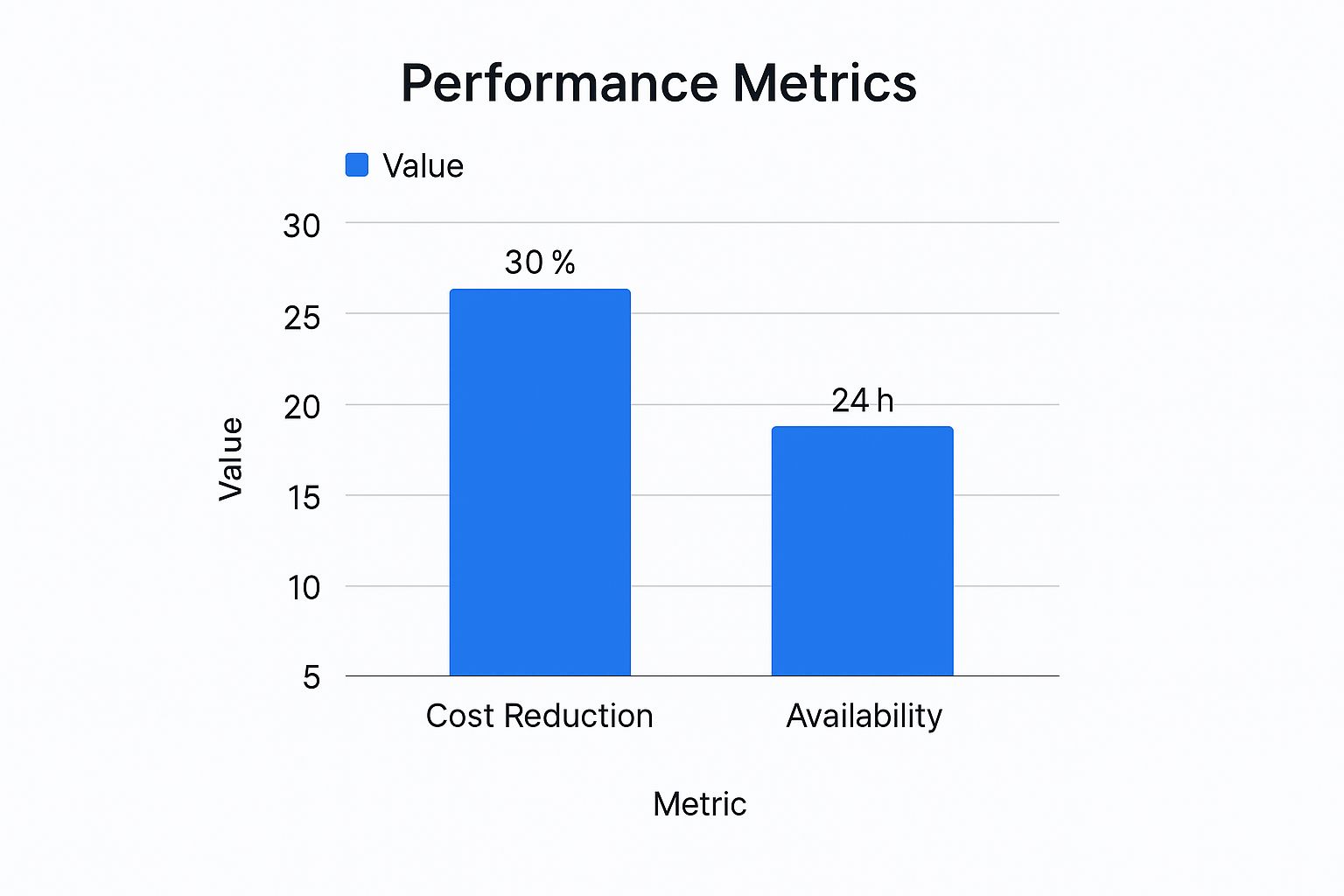
Top Use Cases for Chatbots to Boost Your Business in 2025
Discuss with AI
Get instant insights and ask questions about this topic with AI assistants.
💡 Pro tip: All options include context about this blog post. Feel free to modify the prompt to ask more specific questions!
Chatbots have evolved far beyond simple FAQ bots. Today, they are sophisticated AI-powered tools capable of transforming entire business functions, from generating high-quality leads to providing personalized shopping experiences. The right implementation can dramatically reduce operational costs, increase conversions, and free up your team for high-impact work. This article moves past theory to explore 8 critical use cases for chatbots that savvy businesses are leveraging for tangible growth.
We will not just list examples; we will dissect them. For each use case, you will get a strategic breakdown, tactical insights, and replicable methods you can implement immediately. Whether you're in e-commerce, customer support, or marketing, this guide is designed to provide clear, actionable blueprints.
The goal is to show you how and why specific chatbot strategies work. We'll detail the mechanics behind each application, offering practical takeaways you can apply using a versatile, no-code platform like Spur. By understanding these proven examples, you can identify the most impactful opportunities to integrate chatbot automation into your own workflows. This will help you gain a significant competitive edge by improving efficiency and delivering a superior customer experience across your business.
One of the most powerful and widely adopted use cases for chatbots is revolutionizing customer service and support. By automating responses to common inquiries, these AI-powered assistants act as a tireless, 24/7 first line of defense, freeing human agents to focus on high-stakes, complex issues that require a personal touch.
Chatbots excel at handling high-volume, repetitive tasks. They can instantly answer frequently asked questions (FAQs) about order status, return policies, or shipping details. For example, a customer visiting an e-commerce store can ask the chatbot, "Where is my order?" The bot, integrated with the store's backend systems, can retrieve the tracking information and provide an immediate, accurate update, all without human intervention. This instant gratification significantly boosts customer satisfaction.
Integrating a chatbot into your support workflow is not just about deflecting tickets; it's about creating a more efficient, scalable, and responsive customer experience. Leading companies like Zendesk and Intercom have popularized this by offering platforms that make chatbot deployment seamless. For instance, Bank of America's Erica handles millions of client requests, from checking balances to scheduling payments, showcasing the immense potential for operational efficiency.
The following infographic illustrates the two primary benefits of using chatbots in a support context: significant cost reduction and constant availability.

As the chart highlights, the ability to operate around the clock while reducing operational costs by up to 30% presents a compelling case for adoption.
To effectively implement a customer support chatbot, focus on these key strategies:
- Build a Robust Knowledge Base: Your chatbot is only as smart as the data it can access. Continuously update its FAQ database based on real customer conversations.
- Design Smart Escalation Paths: Program the chatbot to recognize its limitations. Use sentiment analysis to detect frustration and create a seamless handoff to a human agent when a query is too complex or the customer is upset.
- Provide an "Opt-Out": Always give users a clear and easy way to request speaking with a person. A simple button or command like "talk to an agent" is essential for maintaining trust.
Beyond support, chatbots are powerful sales engines that guide customers through the entire buying journey. They act as personal shoppers, available 24/7 to help with product discovery, offer personalized recommendations, and simplify the checkout process. This transforms a static online store into a dynamic, conversational shopping experience.
These AI assistants excel at engaging customers proactively. They can answer specific product questions, assist with sizing and fit, or even help build an entire order conversationally. For instance, the 1-800-Flowers chatbot on Facebook Messenger helps users select the perfect gift by asking a series of questions about the occasion and recipient, making the process feel both personal and efficient.

Integrating a chatbot into your sales funnel isn't just about automation; it's about increasing conversion rates by reducing friction. Platforms like Shopify have made this accessible, while brands like Domino's Pizza pioneered conversational commerce, allowing customers to order a pizza entirely through chat. This showcases another one of the key use cases for chatbots: streamlining transactions. Nike's chatbot similarly provides style advice and product recommendations, acting as an expert stylist to boost average order value.
The following video shows how a chatbot can serve as an effective sales assistant, guiding a user through product selection in an interactive way.
As seen here, chatbots can make shopping more intuitive and less overwhelming, directly impacting sales. For a more comprehensive list of chatbot e-commerce use cases, consider reviewing this dedicated guide.
To effectively leverage a chatbot for e-commerce and sales, implement these strategies:
- Integrate with Inventory: Connect your chatbot to your inventory management system to provide real-time stock availability and prevent customer frustration.
- Recover Abandoned Carts: Program the chatbot to send automated, personalized follow-ups to users who leave items in their cart, offering a small discount or assistance to complete the purchase.
- Use Visual Catalogs: Don't rely on text alone. Implement interactive product carousels and images directly within the chat interface to create a rich, visually appealing shopping experience.
Beyond support, another of the most valuable use cases for chatbots is transforming lead generation and marketing. These AI assistants engage website visitors proactively, acting as a digital concierge to guide potential customers, qualify their interest, and seamlessly capture their information. This turns passive website browsing into an active, conversational experience.
Chatbots can engage visitors with personalized opening lines, ask qualifying questions, and collect contact details in a natural, low-friction way. For example, instead of a static form, a chatbot can ask, "What brought you here today?" and, based on the response, guide the user to relevant content or offer to schedule a demo. This interactive approach significantly increases conversion rates compared to traditional pop-ups.

Integrating a chatbot for marketing automates the top of the funnel, ensuring no potential lead is missed, regardless of the time of day. This strategy, pioneered by platforms like Drift and HubSpot, focuses on "conversational marketing" to build relationships from the very first interaction. HubSpot’s chatbot builder, for instance, allows marketers to qualify leads, book meetings, and sync data directly into their CRM without any manual effort. These chatbots are a core component of modern marketing automation strategies, driving efficiency and lead quality.
This approach allows for immediate engagement and qualification, nurturing prospects while their interest is at its peak and shortening the sales cycle.
To leverage chatbots for effective lead generation, implement these tactics:
- Use Progressive Profiling: Don't ask for all information at once. Program the bot to gather data conversationally over multiple interactions, making the process feel less intrusive.
- Implement Branching Logic: Design conversation flows that adapt based on user responses. Segment users in real-time by asking about their role, company size, or pain points to deliver hyper-relevant information.
- Deliver Gated Content: Use the chatbot as a gatekeeper for valuable resources like ebooks or webinars. Instead of a form, the chatbot can qualify the user and deliver the content directly in the chat window after capturing their email.
One of the most transformative use cases for chatbots is in the healthcare sector, where they provide scalable, accessible, and immediate medical assistance. These AI tools serve as a digital front door for patients, offering everything from symptom assessment and appointment scheduling to medication reminders and mental health support. They help triage patient needs, deliver crucial health education, and streamline administrative tasks for providers.
Chatbots in this field excel at providing initial guidance and support, available 24/7. For instance, a user experiencing non-emergency symptoms can interact with a chatbot to understand potential causes and receive advice on the appropriate next steps, such as self-care or seeing a doctor. This immediate, on-demand interaction can alleviate patient anxiety and reduce unnecessary visits to emergency rooms, optimizing healthcare resources.
Deploying a chatbot in healthcare is about empowering patients and increasing operational efficiency for providers. The key is to provide reliable, validated information and a clear pathway to human care. Companies like Ada Health and Babylon Health have pioneered this space by creating sophisticated symptom checkers that guide users through a series of questions to assess their condition. Similarly, Woebot offers evidence-based cognitive behavioral therapy (CBT) techniques through a conversational interface, making mental health support more accessible.
These applications demonstrate a crucial strategy: using AI to handle preliminary information gathering and support, which allows clinicians to focus their expertise on diagnosis and treatment. This model significantly improves patient access to care while ensuring that interactions remain secure and compliant with regulations like HIPAA.
To implement a healthcare chatbot responsibly and effectively, focus on these critical strategies:
- Prioritize a Medical Disclaimer: Always begin interactions with a clear disclaimer stating the chatbot does not provide a medical diagnosis and is not a substitute for a professional healthcare provider.
- Ensure Data Security and Compliance: All patient data must be handled in strict accordance with HIPAA or other relevant regional privacy regulations. This is non-negotiable for building trust and avoiding legal issues.
- Design Clear Escalation Protocols: The chatbot must be able to recognize urgent situations or its own limitations. Create seamless, immediate handoffs to healthcare professionals, telehealth services, or emergency lines when necessary.
Beyond external customer interactions, chatbots are transforming internal operations, particularly in Human Resources. By acting as virtual HR assistants, these AI tools streamline processes, improve employee engagement, and provide instant, 24/7 support for a modern workforce. This is one of the most impactful internal use cases for chatbots.
Chatbots automate responses to common employee questions about company policies, benefits, leave balances, and onboarding procedures. An employee can ask a chatbot, "How many vacation days do I have left?" and receive an immediate, personalized answer by integrating with the company's HRIS. This frees up HR professionals from repetitive administrative work, allowing them to focus on strategic initiatives like talent development and employee well-being.
Implementing an HR chatbot is about enhancing the employee experience through efficiency and accessibility. By automating routine inquiries, companies create a self-service model that empowers employees with instant information. For example, IBM's Watson Assistant for HR successfully handles thousands of employee queries, while platforms like Workday and ServiceNow use conversational AI to simplify complex processes like performance reviews and IT requests.
This automation is a core component of broader efficiency strategies. To see how this fits into a larger operational context, you can explore more business process automation examples to understand its full potential. The key is to offload high-volume, low-complexity tasks to AI, making the entire department more agile and responsive.
To effectively deploy an HR and employee engagement chatbot, consider these essential strategies:
- Integrate with Core HR Systems: Connect your chatbot to your Human Resource Information System (HRIS) like BambooHR or Workday. This ensures employees receive accurate, personalized data regarding their pay, benefits, and leave.
- Establish Clear Escalation Paths: Not all HR issues can be solved by a bot. Program clear triggers for when a conversation should be handed off to a human HR representative, especially for sensitive or complex personal matters.
- Prioritize Data Security: Employee data is highly sensitive. Ensure your chatbot platform is compliant with data privacy regulations like GDPR and has robust security protocols to protect personal information.
The financial sector represents one of the most security-sensitive and impactful use cases for chatbots. By automating routine inquiries and providing instant financial insights, banking chatbots help institutions deliver secure, 24/7 service while enhancing user engagement. These AI assistants manage everything from simple balance checks to complex fraud alerts and initial loan qualification steps.
Chatbots in finance excel at handling high-volume, standardized tasks with precision. For example, a user can ask a banking bot, "What was my spending on groceries last month?" The bot, integrated securely with the user's account data, can provide a detailed breakdown instantly. This frees human advisors to handle more nuanced financial planning and high-value client relationships, improving overall operational efficiency and customer trust.
Deploying a chatbot in banking is about more than just convenience; it's a strategic move to offer proactive, personalized financial guidance at scale. Industry leaders have pioneered this approach, demonstrating its immense value. For instance, Bank of America's Erica has become a comprehensive digital assistant for millions, handling account management and providing proactive spending insights. Similarly, Capital One's Eno actively monitors transactions and alerts users to potential fraud, turning the chatbot into a vital security tool.
These examples show that a well-implemented financial chatbot acts as a digital companion, empowering customers to manage their finances more effectively. They build confidence by providing immediate access to information and support within a secure, encrypted environment, a critical component of modern digital banking.
To successfully launch a chatbot in the financial services space, focus on security and value:
- Prioritize Multi-Layered Security: Implement robust security protocols like multi-factor authentication (MFA) and end-to-end encryption for all data transmission and storage.
- Design Clear Escalation to Advisors: The chatbot must recognize when a query requires human expertise, such as complex investment advice or a sensitive complaint. Ensure a seamless and secure handoff to a human advisor.
- Provide Proactive, Valuable Insights: Go beyond reactive answers. Use the bot to analyze spending patterns, notify users of upcoming bill payments, or alert them to low balances to help prevent overdraft fees.
Chatbots are transforming the educational landscape by acting as on-demand virtual tutors and learning assistants. This application of chatbot technology provides scalable, personalized learning experiences, making education more accessible and engaging. They can answer student questions 24/7, deliver bite-sized course content, and quiz users to reinforce knowledge.
These AI tools are particularly effective in supporting both formal education and corporate training. For instance, a language learning app like Duolingo uses chatbots to simulate real conversations, helping users practice new vocabulary and grammar in a low-pressure environment. Similarly, Georgia State University’s Pounce chatbot answers thousands of student questions about admissions and financial aid, ensuring students get timely help without overburdening staff. This is one of the most impactful use cases for chatbots in modern learning.
Integrating a chatbot for education is about creating an adaptive and interactive learning environment. It moves beyond static content delivery to a dynamic model where learners can proceed at their own pace and receive instant feedback. Companies like Coursera and edX leverage chatbots to handle common student inquiries and guide learners through course materials, demonstrating how AI can effectively supplement traditional teaching methods.
Squirrel AI in China has taken this further, creating a sophisticated adaptive learning system. Its chatbot-driven platform analyzes a student's strengths and weaknesses to create a fully customized learning path, showcasing the immense potential for AI to deliver truly personalized education at scale.
To deploy an effective educational chatbot, concentrate on these core principles:
- Implement Adaptive Learning: Design the chatbot to adjust the difficulty and content based on the user's performance. Use algorithms to identify knowledge gaps and provide targeted exercises or explanations.
- Track and Report Progress: Build in features that allow learners (and instructors) to monitor progress. Visual dashboards showing completed modules, quiz scores, and areas needing improvement can significantly boost motivation.
- Offer Multiple Explanation Styles: Not everyone learns the same way. Program your chatbot to provide information in different formats, such as text, video clips, or interactive diagrams, to cater to diverse learning preferences.
Chatbots are transforming the travel and hospitality industry by serving as personal, on-demand travel concierges. They assist customers throughout their entire journey, from initial planning and booking to in-trip support and post-travel feedback. These AI assistants manage flight and hotel reservations, provide real-time updates on itineraries, and offer local recommendations, creating a seamless and stress-free travel experience.
This technology excels at providing instant, 24/7 support to travelers across different time zones. A user can interact with a chatbot to find the best flight deals, book a hotel room, or even check the weather at their destination. For example, KLM Royal Dutch Airlines’ bot on Messenger, BlueBot, allows passengers to receive their booking confirmation, check-in notification, boarding pass, and flight status updates directly in their chat app, streamlining pre-flight logistics.
Implementing a chatbot in travel and hospitality is about enhancing the customer journey with personalized, immediate assistance. The goal is to be a reliable companion, reducing the friction often associated with travel planning and management. For instance, Expedia's chatbot helps users find and book hotels and flights through a conversational interface, while Marriott's ChatBotlr assists guests with room service requests and local information. This level of personalized service builds loyalty and improves operational efficiency.
For those in the travel and hospitality sector, chatbots can revolutionize guest communication and streamline operations. Learn how to create your AI assistant for Airbnb to enhance your guest experience. The key is integrating with booking engines and global distribution systems to provide live data, making this one of the most practical use cases for chatbots.
To deploy a successful travel and hospitality chatbot, concentrate on these essential strategies:
- Integrate with Booking APIs: Connect your chatbot to major booking platforms and Global Distribution System (GDS) APIs to offer real-time pricing, availability, and instant booking capabilities.
- Provide 24/7 Global Support: Travel happens across all time zones. Ensure your chatbot is always available to handle urgent requests like flight changes, cancellations, or last-minute accommodation needs.
- Use Location-Based Services: Leverage geolocation to provide hyper-relevant recommendations. Suggest nearby restaurants, attractions, or transportation options based on the user's current location to add significant value to their trip. Learn more about how Spur can enhance your Travel & Hospitality Services.
Use Case Implementation Complexity 🔄 Resource Requirements ⚡ Expected Outcomes 📊 Ideal Use Cases 💡 Key Advantages ⭐ Customer Service & Support Medium - requires integration with CRM and ongoing training Moderate - needs data access, QA, multi-language support 20-40% reduction in costs, improved satisfaction 24/7 support, FAQ handling, multilingual service Reduces workload, instant responses, cost-saving E-commerce & Sales Assistance Medium - integrates catalogs, payment, cart systems High - product databases, inventory sync 10-25% conversion lift, reduced cart abandonment Product discovery, personalized shopping, checkout Personalized recommendations, multi-channel use Lead Generation & Marketing Medium - needs marketing automation, branching logic Moderate - CRM and analytics integration 30-50% higher lead qualification rates Lead capture, appointment scheduling, nurturing Increases leads, consistent messaging, 24/7 engagement Healthcare & Medical Assistance High - stringent compliance, data privacy, EHR integration High - requires secure, HIPAA-compliant systems Improved access, lower no-shows, 24/7 guidance Symptom checking, appointment scheduling, reminders Regulatory compliant, efficient triage, health education HR & Employee Engagement Medium - HRIS integration, policy updates Moderate - data security and privacy controls 50-70% faster HR inquiry response Employee FAQs, leave requests, onboarding Reduces HR workload, consistent info, quick replies Financial Services & Banking High - security, compliance, multi-factor authentication High - encryption and audit capabilities Reduced branch visits, faster transactions Account info, transactions, fraud alerts Secure 24/7 service, personalized insights, cost-effective Education & Learning Support Medium - content development, LMS integration Moderate - curriculum alignment, adaptive tech 15-25% improved retention, scalable support Tutoring, assessments, progress tracking Personalized learning, reduces instructor load, 24/7 help Travel & Hospitality Services Medium - multiple API integrations, real-time updates Moderate - booking systems, location services 20-40% higher booking rates, 30% service cost cuts Flight/hotel bookings, itinerary management Simplifies planning, real-time info, multi-time zone support
As we've explored throughout this guide, the diverse and powerful use cases for chatbots are no longer a futuristic novelty but a foundational element of modern business strategy. From providing instant, 24/7 customer support to driving highly qualified leads through personalized marketing funnels, AI-powered conversational agents have proven their value across every conceivable industry.
The journey from manual processes to automated efficiency can seem daunting, but the path forward is clearer than ever. We've seen how chatbots can revolutionize e-commerce by guiding customers to the perfect product, streamline HR by onboarding new hires, and even provide critical support in sensitive sectors like healthcare and finance. The common thread connecting these successful implementations is a clear, strategic starting point.
The key takeaway is that you don't need to automate everything at once. The most successful chatbot strategies begin with a focused objective. Instead of aiming for a "do-it-all" bot from day one, identify the single most significant point of friction in your operations or the biggest opportunity for growth.
Consider these strategic starting points based on the examples we've covered:
- Customer Support: Is your team overwhelmed by repetitive questions? Start with a FAQ bot to handle the top 10 most common inquiries.
- Sales & E-commerce: Are you losing potential customers due to cart abandonment? Implement a chatbot to re-engage users with a discount or offer assistance.
- Lead Generation: Is your lead qualification process slow and manual? Deploy a chatbot on your key landing pages to ask qualifying questions and book demos automatically.
This targeted approach allows you to measure your return on investment directly and demonstrate value quickly. You can track metrics like reduced response times, increased conversion rates, or a higher number of qualified leads passed to your sales team.
The true power of modern chatbots lies in their accessibility. You no longer need a dedicated team of developers to build and deploy sophisticated conversational AI. The focus has shifted from complex coding to smart strategy.
Your next steps should be clear and deliberate:
- Identify Your Core Objective: Pinpoint the single most impactful problem you want to solve or the primary goal you want to achieve.
- Map the Conversation: Outline the ideal user journey. What questions will the user have? What information does the bot need to collect? What is the desired outcome?
- Choose the Right Platform: Select a tool that integrates seamlessly with your existing technology stack (like your CRM, e-commerce platform, and messaging channels) and allows for no-code development.
- Launch, Analyze, and Iterate: Deploy your initial bot, monitor its performance closely, and use the insights to refine its conversational flows and improve its effectiveness.
Ultimately, mastering the use cases for chatbots is about more than just adopting new technology. It's about fundamentally rethinking how you engage with your customers, support your employees, and scale your operations. By embracing automation strategically, you free up your human team to focus on high-value, complex tasks that truly drive your business forward. The era of intelligent, automated conversation is here, and the opportunities are limitless.
Ready to turn these chatbot use cases into reality for your business? Spur provides a powerful, no-code platform that unifies all your customer conversations from channels like WhatsApp, Instagram, and web chat into a single inbox. Visit Spur to see how you can build and deploy intelligent chatbots in minutes, automating your support, sales, and marketing to drive growth today.
